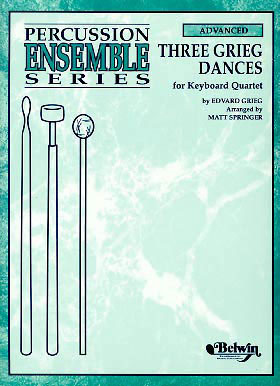Three Grieg Dances (for mallet percussion quartet)
-- Edvard Grieg, arr. by Matt Springer
These three pieces by Grieg are very well suited for this mallet percussion ensemble instrumentation, consisting of four players using orchestra bells, xylophone, marimba (4-1/2 octave low F), vibraphone, and triangle. A 4-1/3 octave low A marimba can be used if necessary, but it is more effective with a low F instrument. Having two sets of orchestra bells makes it easier to play, but it can be done with two players on one instrument. This ensemble is rated for advanced high-school players and up.
Original Belwin edition (1996) |
Sheet Music Availability
Three Grieg Dances was premiered and recorded at Stanford University on March 3, 1996. The sheet music was published by Belwin-Mills (later Warner Bros.) later the same year. The initial print run ended in 2007, although it is still available from various sources. The 2nd Edition has been released as a Khach-22 production; this is available from the Steve Weiss Music percussion catalog.
NOTE: There is a tempo error in the original Belwin edition. In Movement 3, Rigaudon, the tempo was incorrectly listed as quarter note = 138; it should be half note = 138. Also, the tempo for the middle section of that movement was omitted; it should be half note = 76. This is fixed in the new edition.
You don't understand the new cover design?
(For non-percussionists: What are these instruments?)
Streaming audio of individual movements
| Use the mp3 links below (may require you to download the free Quicktime Player; button at right) |
From live performance: Jung Choi, bells; Chi Zhang, xylophone/marimba; Victor Lee, vibraphone; Matt Springer, marimba
| 1. Norwegian Dance #1 |
| 2. Arabian Dance |
| 3. Rigaudon |
These recordings were derived primarily from the premiere performance of the music in 1996 at a public recital. Despite the fact that it was not a professional performance, it is still a good source of interpretation for those who are unsure of how certain passages are meant to sound. The recordings are for reference only and are not commercially available.
Download the detailed performance notes (also supplied with the sheet music):
1996 Belwin edition
2008 Khach-22 edition
Program notes:
The experience of arranging and publishing Khachaturian's music for mallet percussion was so rewarding that I decided to try my hand at it again, this time with the Norwegian composer Edvard Grieg. The suite consists of (1) Norwegian Dance No. 1, from the Norwegian Dances, (2) Arabian Dance, from the Peer Gynt Suite, and (3) Rigaudon from the Holberg Suite. Since mallet percussion consists essentially of hitting things with sticks, it is a bit of a challenge to avoid too much of a bombastic sound during the fast sections, and it can be downright difficult to write soft and pretty parts for mallet instruments. Three Grieg Dances was no exception, and as in my previous arrangements, the xylophone player frequently moves to the marimba during the slow sections, making for some interesting choreography for both the players and their mallets. In addition, the xylophone player and the bell player must be good friends, as they share personal space quite a bit in the 2nd movement.Review from Percussive Notes Magazine, June 1997 p. 75:
KEYBOARD PERCUSSION ENSEMBLE
Three Grieg Dances
Edvard Grieg, Arranged by Matt Springer
$28.95, Belwin Mills, c/o Warner Bros. Publications...Three Grieg Dances is a challenging percussion ensemble for four players utilizing two sets of bells, xylophone, two* marimbas (4 1/3 octave and 4 1/2 octave), vibraphone, and triangle. The quartet can be played using one set of bells and one 4 1/2 octave marimba; however, instruments would need to be shared, causing logistical problems between performers. Players II and IV need to have adequate four-mallet technique (double vertical strokes and independent strokes) in order to perform the parts successfully. The individual dances are: Norwegian Dance #1, Arabian Dance and Rigaudon. Springer provides excellent performance notes, and the parts and score are clear and concise. Additionally, he includes mallet selections for each part, and the vibraphone part has distinctive pedal markings. --Lisa Rogers
*Note: The original published version called for two marimbas. However, it is straightforward to do it with two players using one low F marimba; that is how I performed this at its premiere.
Back to other Springer arrangements
If you encounter any trouble with this website, please e-mail me.

